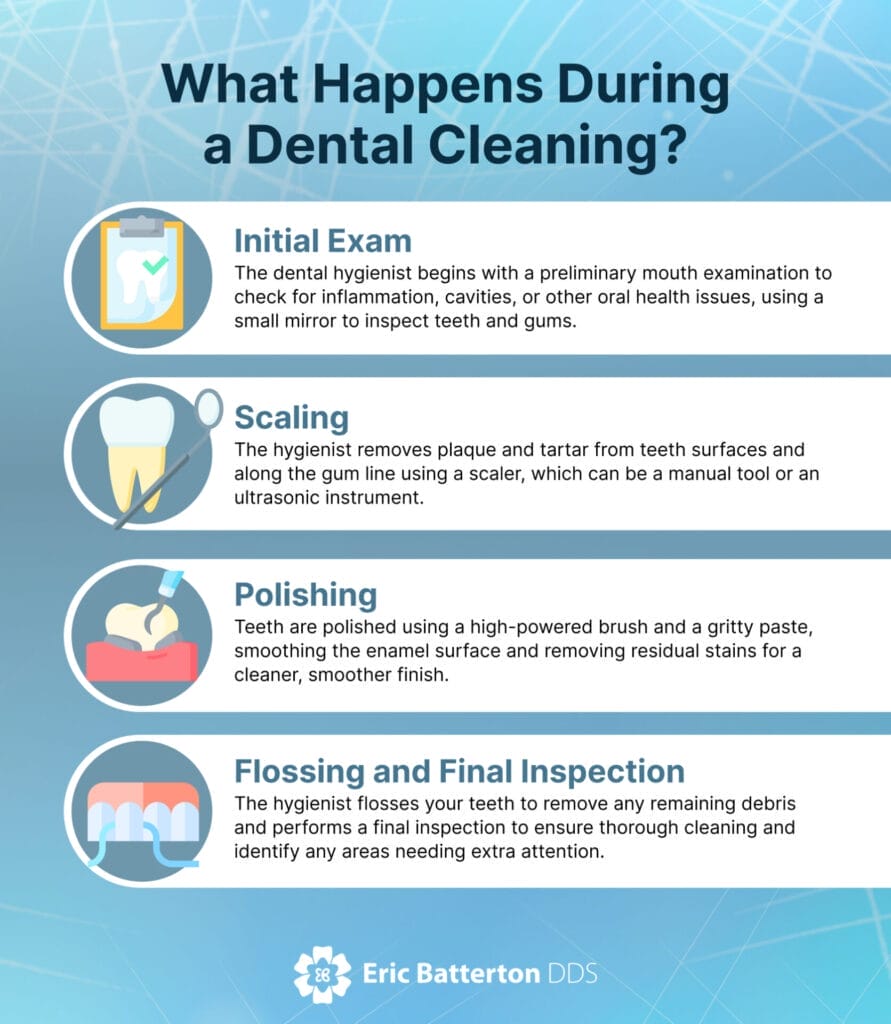Dental cleanings are a crucial part of maintaining oral health, but many people wonder, “How long does a dental cleaning take?”
On average, a dental cleaning takes between 30 to 60 minutes. This timeframe includes thorough plaque removal, polishing, and a comprehensive check for any signs of serious oral health issues.
Read on to explore what happens during a cleaning and why each step is vital for your dental health.
What Happens During a Dental Cleaning?

A dental cleaning, while seemingly straightforward, involves several crucial steps that contribute to maintaining your oral hygiene.
Here’s what typically happens during this routine visit to your dentist:
Preparation and Initial Exam
Before the actual cleaning begins, your dental hygienist will start with a preliminary examination of your entire mouth. This is to check for any signs of inflammation, cavities, or other oral health concerns related to your gum tissue.
They might use a small mirror to inspect teeth and gum health, ensuring that no underlying issues will complicate the cleaning process.
Scaling
Scaling is the first major step of the cleaning itself, where the dental hygienist removes plaque and tartar (hardened plaque) from your tooth surfaces and along the gum line.
They use a tool called a scaler, which might be a manual hand tool or an ultrasonic instrument that uses vibrations to loosen larger deposits of tartar and wash them away with water.
This step is critical as plaque and tartar buildup can lead to gum disease if left untreated.
Polishing
After scaling, your teeth will be polished. This step involves using a high-powered brush and a gritty toothpaste-like cleaning paste.
The hygienist will polish each tooth to smooth the surface of the tooth enamel and remove any residual stains. This not only enhances the aesthetic appeal of your teeth but also makes it more difficult for plaque to adhere to the smooth surfaces.
Flossing and Final Inspection
Following polishing, the hygienist will typically floss your teeth.
This helps remove any debris that might have been loosened during the scaling and polishing steps but remained in between the teeth.
Finally, they will conduct a final inspection to ensure that your teeth are clean and to identify any areas that may need a little extra attention during future cleanings. It’s during this stage that you truly see why routine cleanings matter—they allow your dental team to catch minor issues before they become serious.
Factors Influencing the Duration of a Teeth Cleaning
Several factors play into how long you’ll sit in the dentist’s chair during these routine visits.
By understanding these factors, you can better anticipate the time commitment required for a dental cleaning and discuss with your dentist or hygienist any concerns you might have to optimize your experience and care.
Oral Health Status
One of the most significant determinants of the length of a dental cleaning is the current state of your oral health.
Individuals who practice regular brushing, flossing, and dental check-ups may only need a brief session to remove minor plaque buildup and polish the teeth.
However, if you have extensive tartar accumulation, gum disease, or untreated cavities, your hygienist might need more time to thoroughly clean all affected areas.
The presence of gum disease, particularly, requires meticulous care to properly clean the pockets around teeth, which can add time to your cleaning session.
Type of Cleaning
A standard prophylaxis cleaning (preventive services) for someone with good oral health typically takes less time compared to a deep cleaning, which is medically termed as scaling and root planing.
Deep cleanings are necessary when there is significant gum disease and tartar below the gumline, and these sessions can take longer, sometimes requiring multiple visits to fully address the issue.
Patient Comfort and Sensitivity
Some patients may experience discomfort or sensitivity during the cleaning process, especially during scaling or when dealing with gum disease.
Dental professionals need to take breaks and go slowly to ensure the patient’s comfort, which can extend the length of the appointment.
Additionally, children or individuals with dental anxiety might need extra time for reassurance and to ease into the process.
Frequency of Visits
Regular visits allow for quicker cleanings since there’s less time for problems to develop or worsen.
Conversely, if you visit the dentist less frequently, more time may be needed to manage accumulated dental issues.
Keep Your Smile Bright with Routine Cleanings Today
If concerns about time or uncertainty have delayed your dental appointments, now is the perfect moment to act. Dr. Eric Batterton, D.D.S., and his dedicated dental team are committed to providing a comfortable and efficient cleaning experience.
Book your appointment today, and let’s work together towards a healthier, more confident smile.
FAQs
Is it normal to feel discomfort or pain during or after a professional dental cleaning?
It’s common for patients to experience some discomfort, especially if there has been a long period since the last cleaning.
Sensitivity and mild pain can occur but usually subside within a couple of days.
Persistent discomfort should prompt a follow-up with your dentist.
Why do my gums bleed during a cleaning?
Bleeding during a cleaning is often a sign of gingivitis or gum inflammation. This is typically due to plaque and tartar buildup that irritates the gums.
Regular dental cleanings help to mitigate this issue by removing the irritants and promoting healthier gums.
How often should I get my teeth cleaned?
Dental professionals usually recommend that teeth be cleaned every six months.
For those with a history of periodontal disease or other dental issues, more frequent cleanings may be advised to better manage oral health.
What happens if I skip dental cleanings?
Skipping dental cleanings can lead to increased plaque and tartar buildup, which are the primary causes of gum disease and tooth decay.
Consistent cleanings are vital to prevent these conditions and to maintain optimal oral health.
How much does a dental cleaning cost, and is it covered by insurance?
The cost of dental cleanings varies, but most dental insurance plans cover bi-annual cleanings as preventive care. It’s important to consult with your insurance provider to understand the specifics of your coverage.
